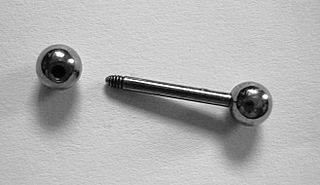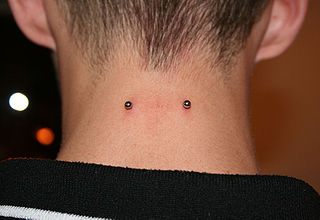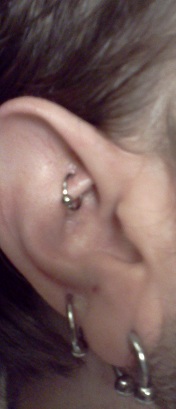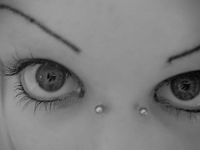
The Prince Albert (PA) is a penis piercing which extends from the urethra to the underside of the glans. It is one of the most common male genital piercings. The related reverse Prince Albert piercing enters through the urethra and exits through a hole pierced in the top of the glans.

A navel piercing is a type of piercing that penetrates the skin of the navel. It is most commonly located on the upper fold of skin but can also be affected underneath or around the edges of the navel. Healing usually takes around 6–12 months but varies person-to-person due to differences in physiology.

A clitoral hood piercing is a female genital piercing through the clitoral hood surrounding the clitoris. In addition to being an adornment, a clitoral hood piercing can enhance sexual pleasure during masturbation, foreplay and intercourse. In an empirical study at the University of South Alabama, the authors reported a positive relationship between vertical clitoral hood piercings and desire, frequency of intercourse, and sexual arousal. There are two main types of clitoral hood piercing: the vertical clitoral hood (VCH) piercing and the horizontal clitoral hood (HCH) piercing. As the names indicate, the difference is in the direction the piercing is oriented in the skin above the clitoris. Neither of these piercings penetrates the clitoris itself, although in common parlance they are sometimes called "clit" piercings. The deep hood piercing is a variation of the clitoral hood piercing that passes deeper through the clitoral hood.

Nose piercing is the piercing of the skin or cartilage which forms any part of the nose, normally for the purpose of wearing jewelry, called a nose-jewel. Among the different varieties of nose piercings, the nostril piercing is the most common.

An earring is a piece of jewelry attached to the ear via a piercing in the earlobe or another external part of the ear, or, less often, by some other means. Earrings have been worn in diverse civilizations and historic periods, often carrying a cultural significance.

An eyebrow piercing is a vertical surface piercing, wherein a twelve to eighteen gauge cannula needle is inserted through the bottom of the eyebrow and exits through the top of the eyebrow to permit insertion of jewellery. Those performing the piercing may use a pennington clamp to better guide the needle through the skin. A curved barbell is the most common jewellery inserted post-piercing.

A tongue piercing is a body piercing usually done directly through the center of the tongue. Since its decline in popularity around 2011, it has seen a recent upsurge making it now the second most popular piercing amongst young women aged 18-25 in 2019. It has become quite unpopular amongst men, although in the 1990s and early 2000s, it was more popular for men than women to get and associated with punk culture. Midline tongue piercings, or one hole through the center of the tongue is the most common way to have the tongue pierced.

A frenum piercing is a type of body piercing located on the underside of the shaft of the penis. A series of parallel frenum piercings is known as a frenum ladder. A frenum ladder may be extended to include lorum piercings, hafada piercings and guiche piercings.

A hafada piercing is a surface piercing anywhere on the skin of the scrotum. Piercings on the scrotal raphe or "seam" of the scrotum are common. This piercing does not penetrate deep into the scrotum, and due to the looseness and flexibility of the skin in that area, does not migrate or reject as much as many other surface piercings. The main motives are beautification and individualization. A piercing that passes through the scrotum, from front-to-back, or from side-to-side, is known as a transscrotal piercing. Multiple hafada piercings are not uncommon, often as an extension of a frenum ladder or Jacob's Ladder, which is a series of piercings from the frenulum to the scrotum.

A Christina piercing, also known as a Venus piercing, is a female genital piercing. It is located where the outer labia meet, below the pubic mound. The Christina piercing is anatomy dependent; it has a high rejection rate, and is not possible for all women due to anatomical variation. If the flesh above the clitoris where the outer labia meet is fleshy enough to pinch, a Christina piercing may be successful. If the flesh in this area is too tight to pinch, a Christina piercing is contraindicated. The piercing does not facilitate sexual stimulation and can be found uncomfortable when pressure is applied. It is usually pierced with either a custom-made curved barbell or surface bar to reduce the risk of rejection.

A transscrotal piercing is a body piercing that travels through the scrotum from front to back, or from side to side. It is a high risk procedure.

Barbell style piercing jewelry is composed of a straight bar with a bead on each end, one or both beads unscrewable for removal and/or changing of the beads. Often one of the beads is fixed, either via epoxy or welding, so that only one bead is used to install or remove the jewelry. Barbell threads are usually right-handed.

An industrial piercing, also known as a scaffold piercing (UK/Ireland) or construction piercing, is any ear piercing that consists of two pierced holes connected with a single piece of jewelry. These piercings typically consist of a double perforation of the upper ear cartilage specifically. Two piercings must be made: one is fairly close to the head, while the second one is further down the helix on the opposite side of the ear. Industrial piercings that are vertical are also known as a suicide industrial.

A nape piercing is a piercing through the surface of the nape of the neck. Nape piercings are a type of surface piercing. They carry a high rate of rejection and migration, unless they are properly measured and placed. They may reject if they are not pierced properly, as they are in a part of the body that moves constantly and are easy to irritate, catching on clothing or other objects.

A guiche piercing is a body piercing through the perineum. Guiche piercings are much more common in men than in women. Although a guiche normally runs perpendicular to the direction of the penis, lateral placements are possible. A series of guiche piercings in parallel to the direction of the penis is called a guiche ladder, and might commonly be seen as an extension of a frenum ladder.

A rook piercing is a perforation of the antihelix of the ear for the purpose of wearing jewelry. It is located just above the tragus on the ridge between the inner and outer conch with the piercing passing from the underside to the top of this ridge, differing from many ear piercings that essentially span between a "front" and "back" surface. Erik Dakota, a well known professional piercer and the individual responsible for originating and popularizing the rook piercing, is said to have named this modification after a shortened version of his first name. The piercing was first named in issue #4 of the magazine Body Play and Modern Primitives Quarterly around 1992 alongside the first printed reference to the industrial piercing, then termed "industrial ear project".

A corset piercing is a body piercing that consists of multiple piercings in rows, usually on the back, with ribbon or string laced through to mimic the appearance of a corset. Two rows of bilaterally symmetrical piercings are performed and can be composed of as few as four piercings or as many as the length of the area being pierced and the vertical space between piercings will allow space for. Due to the difficulty and risks associated with permanently healing single surface piercings, most corset piercings are intended to be temporary.

A Madison piercing is a body piercing going through the skin at the front of the neck. They are surface piercings, and have a high rate of migration and rejection. They have a long healing period, if they heal at all. The Madison piercing is named after the first person publicly associated with it, the porn star Madison Stone.

A philtrum piercing, nicknamed a medusa piercing, is an upper lip piercing placed in the philtrum, directly under the septum of the nose. It is typically pierced using a labret stud as jewelry, with the ball sitting outside the mouth in the dip of the top lip.

In body modification, an implant is a device that is placed under the human skin for decorative purposes. Such implants may be subdermal or transdermal. In the context of body modification, some may consider injections of silicone and other substances a type of implant as well.



















